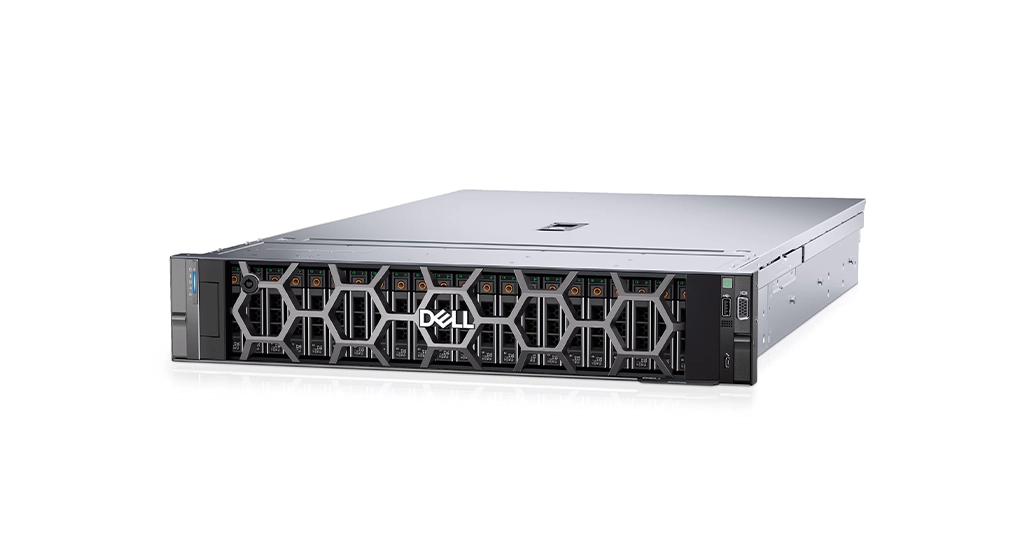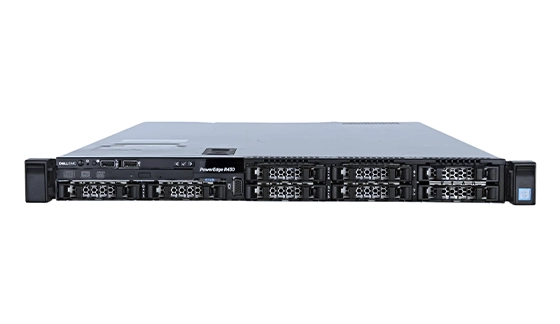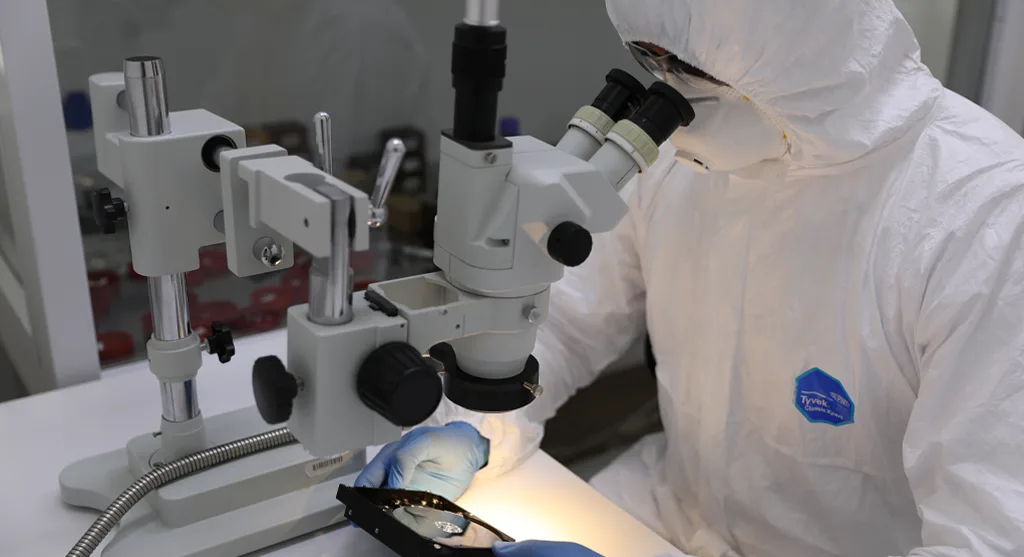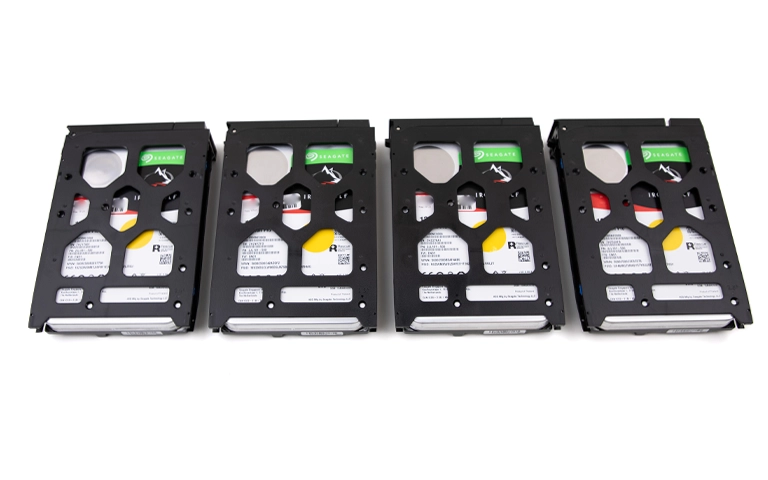A professional services firm recently experienced a severe data loss incident involving their Dell PowerEdge 440 server. The server played a pivotal role in hosting the company’s daily operations, including file shares and multiple Hyper-V virtual machines.
Built for performance and scalability, the system featured a PERC H330 internal RAID controller and a storage configuration consisting of six Seagate Barracuda 5TB drives in a RAID 5 array. An SSD in Slot 0, configured as a standalone (non-RAID) device, housed the operating system.
However, disaster struck when the RAID volume unexpectedly vanished from the Windows Server environment. With no external backup in place, the client faced the possibility of catastrophic data loss that could halt their business operations.

Problem Overview: RAID Offline and Drives in Critical States
Initial troubleshooting revealed the following alarming findings:
Drive 00:01:01 was marked as “Removed” and no longer appeared as part of the array.
Drive 00:01:04 was marked “Foreign,” a status indicating that the drive had lost its original RAID metadata.
Dell’s hardware diagnostics confirmed issues, with drive 1 blinking green (signaling hardware failure) and drive 4 showing a steady LED.
Fortunately, the client took a cautious and informed approach. They avoided common mistakes such as attempting to import the foreign configuration or initiating a rebuild. Both actions could have caused permanent data loss by overwriting existing RAID metadata or writing new parity to outdated drives.
The company reached out to RAID Recovery Services, understanding the high stakes involved in dealing with RAID 5 arrays where only one drive failure is tolerated.
For more information on how to safely recover from similar failures, visit our RAID 5 Data Recovery page.

What Was at Risk?
This RAID 5 volume held more than just documents or spreadsheets. It contained the core of the firm’s IT infrastructure, including:
Three Hyper-V virtual machines, including an accounting system and internal web server
Critical operational data such as contracts, financials, and internal reports
Shared office folders used across departments
While the total storage utilization was relatively low (estimated below 10 percent), the value of the data was high, and downtime was already impacting business operations.
Our Recovery Process: Inspection, Imaging, and Reconstruction
Upon receiving the drives at our lab, we immediately began a non-invasive evaluation process using sector-by-sector imaging tools and forensic-grade equipment.
Our cleanroom technicians disassembled and examined each drive to assess physical health and recoverability.
Cleanroom Inspection Findings
Drive 1 and Drive 4, the ones marked “Removed” and “Foreign,” were both physically damaged. Platter inspections under a microscope revealed significant media scratches, making them non-recoverable.
A third drive, which appeared stable on the surface, was identified as the last drive that failed in the sequence. This drive likely held the most recent and complete version of the array’s data. It suffered from a head crash, a common mechanical failure that prevents data from being read properly but does not always affect the platters.
Inside our ISO-certified cleanroom, our engineers performed a successful head swap using an exact-match donor drive. The process involved aligning delicate actuator assemblies with microscopic tolerances and recalibrating read and write access.
Once new heads were in place, we were able to image the entire drive completely, preserving the most recent parity and user data structure.

Fast turnaround times for business-critical data
Reconstructing the RAID 5 Volume
With full disk images from the remaining healthy drives and the successfully recovered one, we began the process of logical reconstruction:
Stripe size, parity rotation, and block order were reverse-engineered using hex-level analysis.
The RAID array was virtually rebuilt in a controlled software environment, eliminating the risk of controller-level interference.
We tested over a dozen potential configurations before verifying the correct RAID layout, ensuring exact alignment of data blocks.
The recovered array was mounted read-only, and integrity checks were run on the recovered file system.
All three Hyper-V virtual machines were successfully located, extracted, and validated for boot integrity and data consistency. Office files and databases were also verified to be fully intact.
If your virtual environment suffers from data loss, learn more about our specialized Hyper-V Data Recovery Services.

Final Results: Full Recovery Within a Week
100 percent of requested data was recovered, including all Hyper-V VMs and office file shares
Recovery was completed within 7 business days, minimizing downtime
Data was securely returned on encrypted external drives
The client successfully re-integrated the VMs into their production environment without data loss or corruption
This successful recovery was made possible because the client avoided rebuilds, preserved the original hardware configuration, and contacted professionals at the right time.
Why RAID Recovery Services?
No rebuild attempts, ensuring data integrity and maximum recovery potential
Cleanroom head swaps and platter-level diagnostics to recover from physical damage
Virtual RAID reconstruction allows recovery even when multiple drives fail
Expertise with Dell PowerEdge servers and PERC RAID controllers ensures confidence in enterprise-level recoveries
To see how we handle complex failures on Dell hardware, visit our Dell Server Recovery Services page.
Whether your RAID system is experiencing logical corruption, multiple drive failures, or mechanical damage, our team has the tools and expertise to recover your data safely and quickly.
Trust the experts with proven results
Frequently Asked Questions
What does “foreign” mean on a RAID drive?
A “foreign” status means the drive’s metadata no longer matches the RAID controller’s current configuration. Importing it without proper validation can cause data corruption.
Can RAID 5 survive two drive failures?
No. RAID 5 can only survive a single drive failure. A second failure, even partial or metadata-related, will render the array inaccessible.
What is a head swap, and why is it needed?
A head swap is a cleanroom procedure where failed read and write heads inside a hard drive are replaced with functional ones from a donor. It is necessary when mechanical failure prevents data from being read.
How do you virtually rebuild a RAID array?
We use specialized software to simulate the array structure by matching stripe size, parity rotation, and block order without altering original data.
How fast can you recover RAID data?
Standard turnaround is 5 to 10 business days. Emergency service options are available with 24-hour evaluation and priority recovery.